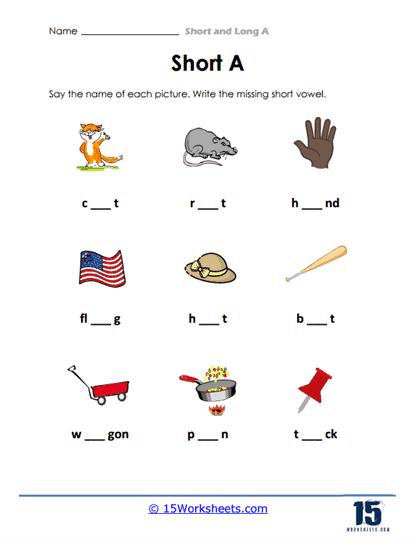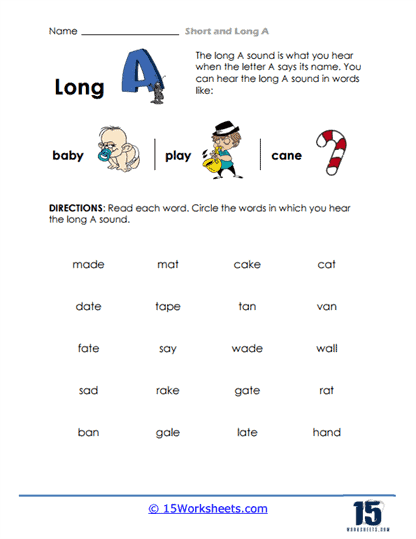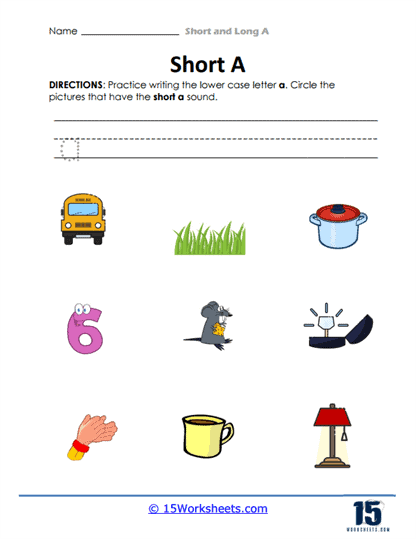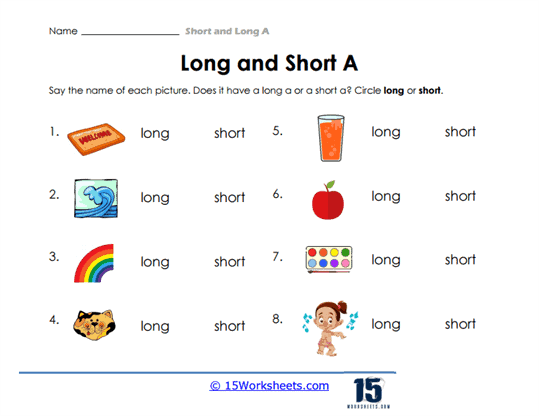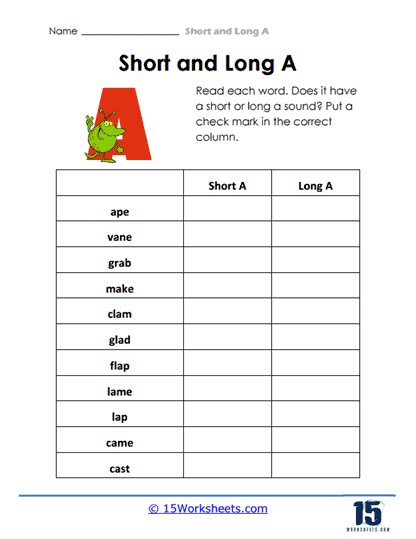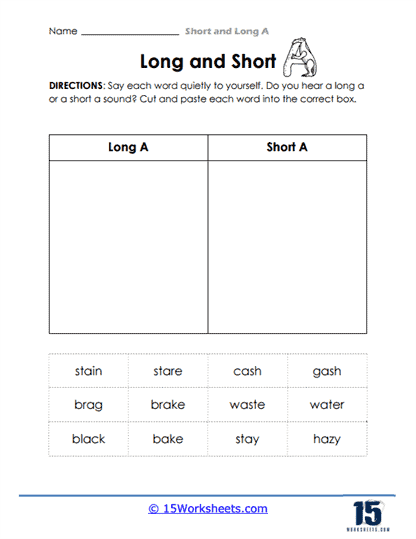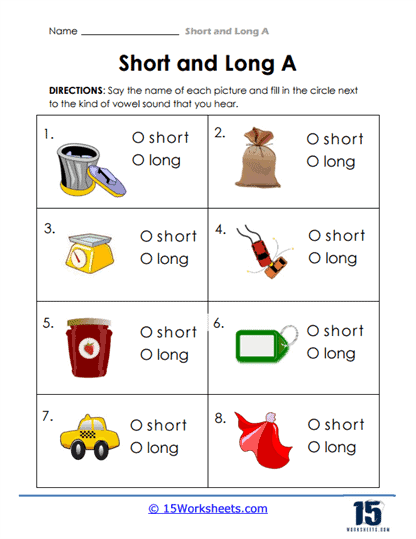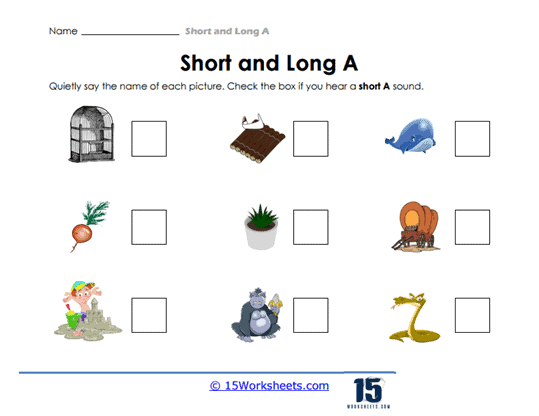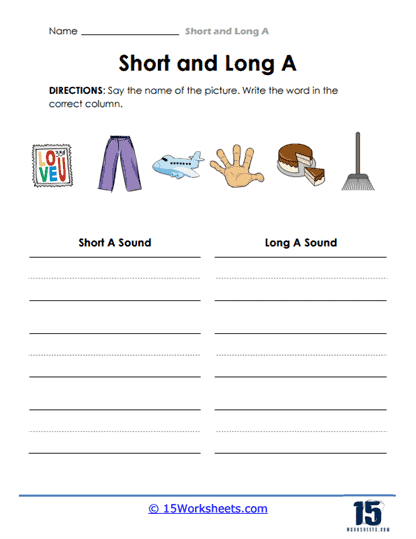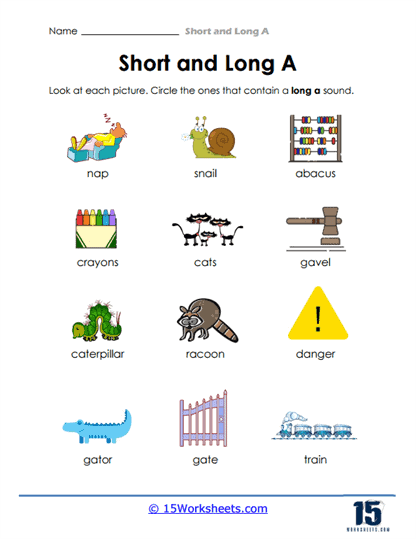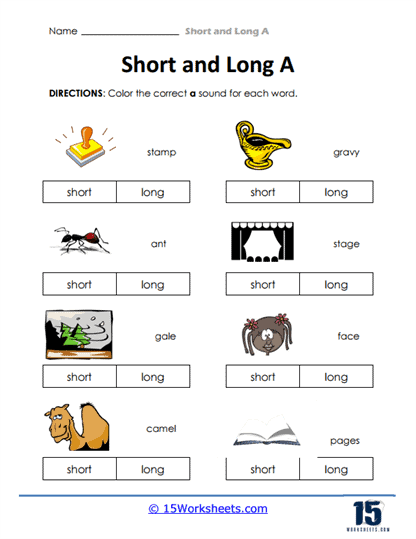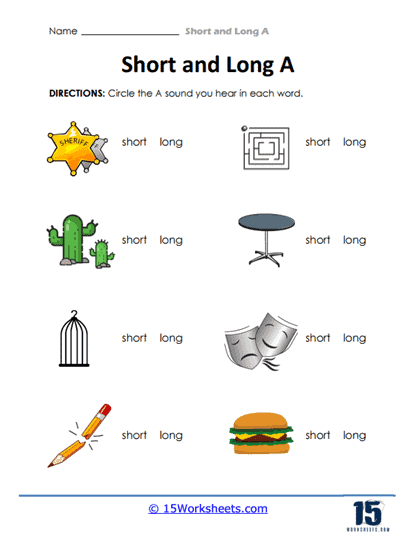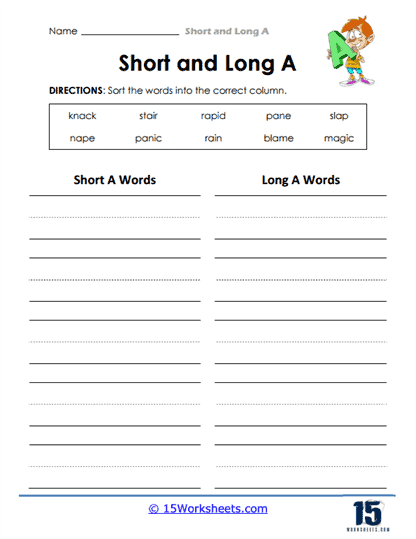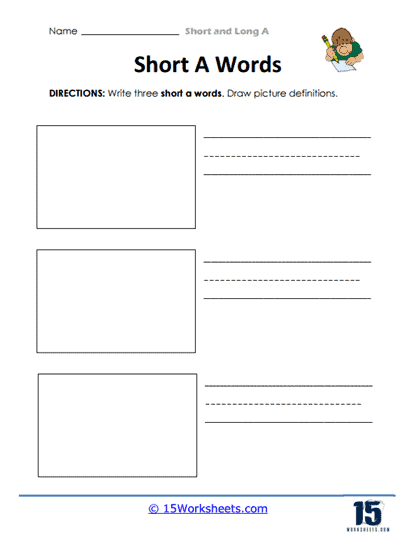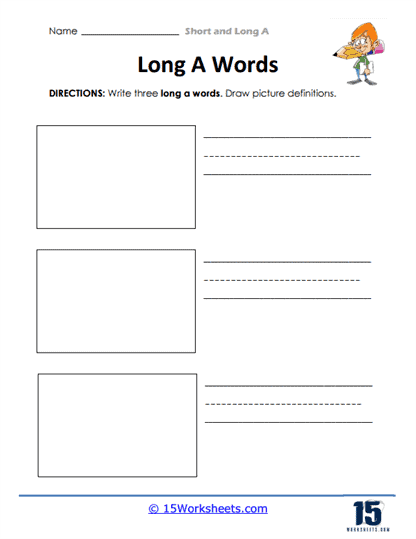Short and Long A Worksheets
All About These 15 Worksheets
Understanding the distinction between short and long vowel sounds, particularly the A sound, is a fundamental building block in early literacy. This skill forms the basis for decoding words and is essential for successful reading and spelling.
To support students in mastering this crucial phonemic awareness skill, we present a collection of Short and Long A worksheets. These worksheets have been thoughtfully designed to provide students with structured and engaging opportunities to practice and refine their understanding of short and long A sounds.
What Are Short and Long A Worksheets?
These worksheets are a cornerstone tool for teaching your child about the different sounds that the letter ‘A’ can make in words. These sounds include the short ‘A’ sound, as heard in words like “cat,” “hat,” or “apple,” and the long ‘A’ sound, as heard in words like “cake,” “rain,” or “play.” Understanding these two different sounds is a critical step in your child’s journey toward reading fluency and comprehension.
As the English language can sometimes seem unpredictable in its phonics patterns, having a solid understanding of long and short vowel sounds can give your child the keys to decode the majority of English words. While there are exceptions, most words follow the rules of these sounds, making them an essential part of your child’s reading toolkit.
Our short and long A worksheets consist of various tasks and exercises, each specifically designed to help students identify the difference between the short ‘A’ and long ‘A’ sounds and apply this knowledge to their reading and spelling.
Sorting Words – In this exercise, your child might be given a list of words and asked to sort them based on whether they contain the short ‘A’ or long ‘A’ sound. This helps to reinforce the difference between these two sounds.
Fill in the Blanks – These tasks provide sentences with missing words, and your child must fill in the blanks with words that have either the short ‘A’ or long ‘A’ sound. This can help them understand how these sounds work in the context of a sentence.
Matching Words to Pictures – This task typically involves matching words to corresponding pictures. For example, a picture of a “cat” would be matched with the word “cat,” and a picture of a “cake” would be matched with the word “cake.” This can help connect the sounds of the words with real-world objects, enhancing understanding and retention.
Word Search Puzzles – Here, your child will look for short ‘A’ and long ‘A’ words hidden in a grid of letters. This type of activity not only helps reinforce the recognition of these vowel sounds but also adds an element of fun to the learning process.
Spelling Practice – In these exercises, your child might listen to a word and then be asked to spell it, or they might be shown a picture and asked to spell the word that describes it. This can be an effective way to improve spelling skills while focusing on the difference between the short ‘A’ and long ‘A’ sounds.
Rhyming Words – This type of activity might ask your child to find pairs of words that rhyme. This can be a fun and engaging way to learn about the short ‘A’ and long ‘A’ sounds, as rhyming words often share the same vowel sounds.
As a parent or teacher, your role in helping your child with these worksheets is significant. Encourage them to voice out the words aloud, helping them to connect the written word with its sound. If they struggle with distinguishing between the short ‘A’ and long ‘A’ sounds, be patient, and guide them through the exercises. When they correctly identify or use these sounds, celebrate their success to keep them motivated.
These worksheets are designed not just to teach but also to make learning fun. With the right approach, the process of learning these vowel sounds can be an enjoyable journey rather than a chore. By the end of it, your child will have made a significant step towards becoming a confident reader and speller, equipped with the knowledge of when ‘A’ says its name and when it does not. Happy learning!
Examples of the Long A Sound
“Cake” – In this word, the ‘A’ makes the long vowel sound, which is the same sound as the name of the letter ‘A’. The reason for this is due to the “silent e” rule in English phonics. When a vowel (in this case ‘A’) is followed by a consonant (here, ‘k’) and then ends in an ‘e’, the ‘e’ is usually silent and the first vowel is long. So, in “cake”, the ‘e’ is silent and the ‘A’ is pronounced as a long vowel, sounding like its name.
“Rate” – Just like “cake”, the word “rate” also follows the “silent e” rule. The ‘A’ is followed by a consonant ‘t’ and ends with an ‘e’. This causes the ‘A’ to make the long ‘A’ sound, and the ‘e’ is silent.
In both “cake” and “rate”, the ‘A’ sounds like its name, ‘ā’, which is characteristic of a long vowel sound. This pattern doesn’t hold true for all English words but it applies in a large number of cases, making it a useful rule for learners of English reading and spelling.
Examples of the Short A Sound
“Cat” – In this word, the ‘A’ makes the short vowel sound, which sounds like ‘æ’ as in “hat” or “bat”. The reason for this is due to a common pattern in English phonics – When a vowel is followed by a consonant and the word ends, the vowel is usually short. So, in “cat”, the ‘A’ is followed by the consonant ‘t’ and the word ends, so the ‘A’ is pronounced as a short vowel.
“Apple” – Here, the first ‘A’ also makes the short vowel sound, ‘æ’. Although “apple” is a two-syllable word, we can apply the same rule by looking at the syllables separately. The first syllable “ap-” ends after the ‘p’ (which is a consonant), so the ‘A’ is short. The ‘-ple’ is a different syllable and does not affect the sound of the ‘A’.
In both “cat” and “apple”, the ‘A’ has a short vowel sound. This is just one pattern that determines the pronunciation of vowels in English, but there are others, and many exceptions to the rules. That’s why it’s important for learners to practice reading and listening to English in different contexts to familiarize themselves with the various sounds vowels can make.
The Importance of Short and Long A
Understanding the difference between short and long vowel sounds, including the A sound, is of paramount importance for several reasons:
- Reading Proficiency: Accurate recognition of short and long vowel sounds is essential for fluent reading. It enables students to decode words correctly and comprehend text effectively.
- Spelling Competence: Proficiency in distinguishing short and long vowel sounds enhances students’ spelling skills. When they can differentiate between these sounds, they are better equipped to spell words accurately.
- Phonemic Awareness: Recognizing short and long vowel sounds fosters phonemic awareness, which is the ability to identify and manipulate individual phonemes (sounds). This skill is critical for literacy development and reading comprehension.
- Vocabulary Growth: Learning the nuances of short and long vowel sounds exposes students to a broader range of words, enriching their vocabulary and comprehension.
This collection of Short and Long A worksheets is a valuable resource for educators and parents committed to supporting their students’ phonics and literacy development. Proficiency in distinguishing between short and long vowel sounds, including the A sound, is a foundational skill that opens the doors to reading fluency, comprehension, effective spelling, and vocabulary growth.
By using these engaging worksheets, students will strengthen their ability to recognize and use short and long A sounds with confidence. This collection is an investment in their future success, ensuring they have a solid foundation in phonemic awareness, phonics, spelling, and vocabulary.

